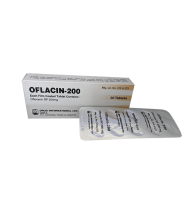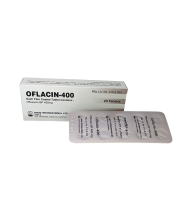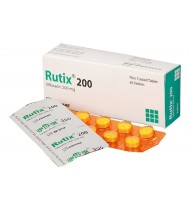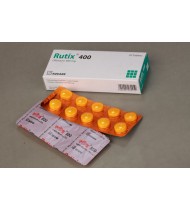Ofloxacin (Oral & Injection)
Indications
Ofloxacin are indicated for the treatment of adults with mild to moderate infections caused by susceptible strains.
- Lower Respiratory Tract: Acute bacterial exacerbation of chronic bronchitis lung abscess, pneumonia.
- Gastrointestinal Tract: Enteric fever, shigellosis.
- Multi-drug-resistant Tuberculosis.
- Skin and skin structures: Uncomplicated skin and skin structure infections.
- Sexually Transmitted Diseases: Acute, Uncomplicated urethral and cervical gonorrhoea. Nongonococcal urethritis and cervicitis. Mixed infections of the urethra and cervix.
- Urinary tract: Uncomplicated Urinary Tract Infections, Complicated urinary tract infections.
Pharmacology
Ofloxacin is a synthetic 4-fluoroquinolone antibacterial agent with bactericidal activity against a wide range of Gram-negative and Gram-positive organisms. Ofloxacin is thought to exert bactericidal effect by inhibiting DNA gyrase, an essential enzyme that is a critical catalyst in the duplication, transcription and repair of bacterial DNA.
Dosage
Intravenous (Adult):
- Skin and soft tissue infections: 400 mg bid infused over at least 1 hr.
- Complicated urinary tract infections: 200 mg daily by infusion over at least 30 min. Max: 400 mg bid infused over at least 1 hr.
- Lower respiratory tract infections, Septicaemia: 200 mg bid by infusion over at least 30 min. Max: 400 mg bid infused over at least 1 hr.
Oral (Adult):
General dosage recommendations: The dose of ofloxacin is determined by the type and severity of the infection. The dosage range for adults is 200 mg to 800 mg daily. Up to 400 mg may be given as a single dose, preferably in the morning, larger doses should be given as two divided doses. Ofloxacin tablets should be swallowed with liquid; they should not be taken within two hours of intake of magnesium/aluminium containing antacids or iron preparations since reduction of absorption of ofloxacin can occur.- Enteric fever: For adults 200 mg, every 12 hours, for 5 days. For children 15 mg/kg/day in 2 divided doses for 3 days.
- Shigellosis: 400 mg single dose.
- Multi-drug-resistant tuberculosis: 400 mg twice daily along with conventional anti-tuberculosis drugs.
- Lower respiratory tract infection: 400 mg daily, increasing, if necessary, to 400 mg twice daily.
- Uncomplicated Urinary Tract Infections: A single dose of 200/400 mg.
- Uncomplicated urethral and cervical gonorrhoea: A single dose of 400 mg.
- Non-gonococcal urethral and cervicitis: 400 mg daily in single or divided doses.
- Complicated Urinary Tract Infection: 200/400 mg/day for 7 days.
Elderly: No adjustment of dosage is required in the elderly.
Administration
May be taken with or without food. Avoid antacids or supplements containing Fe or Zn within 2 hr before or after ofloxacin. Ensure adequate hydration.
Interaction
Antacids containing magnesium, aluminium or calcium may decrease absorption of ofloxacin. Iron or Zinc may decrease oral absorption of ofloxacin.
Contraindications
Ofloxacin should not be used in-patients with known hypersensitivity to 4-fluoroquinolone antibacterials. It is contraindicated in-patients with a history of epilepsy or with a lowered seizure threshold. Ofloxacin is usually contraindicated in children or growing adolescents and in pregnant or breast feeding women.
Side Effects
Ofloxacin is generally well tolerated and clinical side-effects of ofloxacin has been quite low. Among the adverse effects gastrointestinal and central nervous systems' reactions are common. Nausea, rash, vomiting, abdominal pain, diarrhoea and gastrointestinal distress are the gastrointestinal adverse effects. Common central nervous system reactions are headache, dizziness and insomnia.
Pregnancy & Lactation
The safety of ofloxacin during pregnancy has not been established. Ofloxacin may enter breast milk but data are not available.
Precautions & Warnings
Patients being treated with Ofloxacin should not expose themselves unnecessarily to strong sunlight and should avoid UV rays. Caution is recommended if the drug is to be used in psychotic patients or in-patients with a history of psychiatric disease.
Use in Special Populations
Renal Impairment:
- CrCl <20 and patients on haemodialysis or peritoneal dialysis: 100 mg 24 hrly following usual initial dose.
- CrCl 20-50: Reduce dose by half 24 hrly following usual initial dose.
Overdose Effects
Symptoms: Confusion, dizziness, impairment of consciousness, convulsive seizures, GI reactions (e.g. nausea, mucosal erosions).
Management: Symptomatic and supportive treatment. Remove any unabsorbed drug by gastric lavage or admin of adsorbants and Na sulfate. Antacids are recommended for protection of gastric mucosa. Elimination may be increased by forced diuresis.
Management: Symptomatic and supportive treatment. Remove any unabsorbed drug by gastric lavage or admin of adsorbants and Na sulfate. Antacids are recommended for protection of gastric mucosa. Elimination may be increased by forced diuresis.
Therapeutic Class
4-Quinolone preparations, Aural Anti-bacterial preparations
Storage Conditions
Store between 15-30° C. Protect from light.
Oflacin Tablet 200 mg
IndicationsOfloxacin are indicated for the treatment of adults with mild to moderate infections..
12.05Tk.
Oflacin Tablet 400 mg
IndicationsOfloxacin are indicated for the treatment of adults with mild to moderate infections..
22.10Tk.
Rutix Tablet 200 mg
IndicationsOfloxacin are indicated for the treatment of adults with mild to moderate infections..
12.09Tk.
Rutix Tablet 400 mg
IndicationsOfloxacin are indicated for the treatment of adults with mild to moderate infections..
22.14Tk.
Showing 1 to 4 of 4 (1 Pages)




